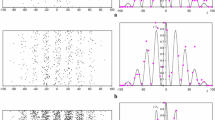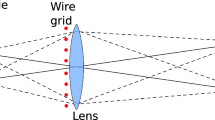Abstract
The traditional analysis of the basic version of the double-slit experiment leads to the conclusion that wave-particle duality is a fundamental fact of nature. However, such a conclusion means to imply that we are not only required to have two contradictory pictures of reality but also compelled to abandon the objectiveness of the truth values, “true” and “false”. Yet, even if we could accept wave-like behavior of quantum particles as the best explanation for the build-up of an interference pattern in the double-slit experiment, without the objectivity of the truth values we would never have certainty regarding any statement about the world. The present paper discusses ways to reconcile the correct description of the double-slit experiment with the objectiveness of “true” and “false”.
Similar content being viewed by others
References
Greiner, W., Bromley, D.A.: Quantum Mechanics: An Introduction (Theoretical Physics). Springer, Berlin (2012)
Bohr, N.: The quantum postulate and the recent development of atomic theory. Nat. Suppl. 121, 580–590 (1928)
Scully, M.O., Englert, B.-G., Walther, H.: Quantum optical tests of complementarity. Nature 351, 111–116 (1991)
Menzel, R., Puhlmann, D., Heuer, A., Schleich, W.P.: Wave-particle dualism and complementarity unraveled by a different mode. Proc. Natl. Acad. Sci. USA 109(24), 9314–9319 (2012)
Feynman, R.P., Leighton, R.B., Sands, M.: The Feynman Lectures on Physics, vol. 1. Addison-Wesley, Boston (1963)
Birkhoff, G., von Neumann, J.: The logic of quantum mechanics. Ann. Math. 37, 823–843 (1936)
Baltag, A., Smets, S.: Quantum logic as a dynamic logic. Synthese 179, 285–306 (2011)
Mateus, P., Sernadas, A.: Weakly complete axiomatization of exogenous quantum propositional logic. Inf. Comput. 204, 771–794 (2006)
Abramsky, S., Duncan, R.: A categorical quantum logic. Math. Struct. Comput. Sci. 16, 469–489 (2006)
Pavicic, M.: Bibliography on quantum logics and related structures. Int. J. Theor. Phys. 31, 373–461 (1992)
Kochen, S., Specker, E.: Logical structures arising in quantum mechanics. In: G. J\(\ddot{{\rm a}}\)ger, H. L\(\ddot{{\rm a}}\)uchli, B. Scarpellini, and V. Strassen, editors, Ernst Specker Selecta, pp. 210–221. Birkh\(\ddot{{\rm a}}\)user, Basel (1990)
Kochen, S., Ernst, S.: The calculus of partial propositional functions. In: Hooker, C. (ed.) The Logico-Algebraic Approach to Quantum Mechanics: Historical Evolution, vol. 1, pp. 277–292. D. Reidel Publishing Company, Dordrecht (1974)
Kochen, S.: A reconstruction of quantum mechanics. Found. Phys. 45, 557–590 (2015)
Church, A.: Introduction to Mathematical Logic. Princeton University Press, Princeton, NJ (1956)
Mendelson, E.: Introduction to Mathematical Logic. Springer, Berlin (1997)
Klement, K.C.: Propositional Logic. In The Internet Encyclopedia of Philosophy. https://www.iep.utm.edu/prop-log/ (2020)
Mirsky, L.: An Introduction to Linear Algebra. Dover Books on Mathematics, Dover Publications, New York (2011)
Sawant, R., Samuel, J., Sinha, A., Sinha, S., Sinha, U.: Non-classical paths in interference experiments. Phys. Rev. Lett. 113(12), 120406 (2014)
von Neumann, J.: Mathematical Foundations of Quantum Mechanics. Princeton University Press, Princeton (1955)
Stephen Cole Kleene: On notation for ordinal numbers. J. Symb. Log. 3, 150–155 (1938)
Priest, G., Sylvan, R.: Simplified semantics for basic relevant logics. J. Philos. Log. 21, 217–232 (1992)
Łukasiewicz, J.: On three-valued logic. In: Borkowski, L., Łukasiewicz, J. (eds.) Selected Works, pp. 87–88. North-Holland, Amsterdam (1970)
Gottwald, S.: A treatise on many valued logics. Press, Res. Stud (2001)
Reichenbach, H.: Philosophic Foundations of Quantum Mechanics. Dover Publications, New York (2011)
Rey, G.: The analytic/synthetic distinction. In: Zalta, E.N. (ed.) The Stanford Encyclopedia of Philosophy. Stanford University, Stanford, Metaphysics Research Lab (2018)
Isham, C.J.: Is it true; or is it false; or somewhere in between? The logic of quantum theory. In: Demopoulos, W., Pitowsky, I. (eds.) Physical Theory and Its Interpretation, pp. 161–182. Springer, The Netherlands (2006)
Humberstone, L.: The connectives. MIT Press, Cambridge, MA (2011)
Bergmann, M.: An Introduction to Many-Valued and Fuzzy Logic: Semantics, Algebras, and Derivation Systems. Cambridge University Press, Cambridge (2008)
Piron, C.: Foundations of Quantum Physics. W. A. Benjamin Inc, New York (1976)
Halmos, P.R.: Introduction to Hilbert Space and the Spectral Theory of Spectral Multiplicity. Chelsea, New York (1957)
Dickson, M.: Quantum logic is alive \(\wedge\) (it is true \(\vee\) it is false). Philos. Sci. 68(3), S274–S287 (2001)
Putnam, H.: Is logic empirical? In: Cohen, R.S., Wartofsky, M.W. (eds.) Boston Studies in the Philosophy of Science, vol. 5, pp. 216–241. D. Reidel Publishing Company, Dordrecht (1968)
Bacciagaluppi, G.: Is logic empirical? In: Engesser, K., Gabbay, D.M., Lehmann, D. (eds.) Handbook of Quantum Logic and Quantum Structures: Quantum Logic, pp. 49–78. Elsevier, New York (2009)
Thomas, G.B., Finney, R.L.: Calculus and Analytic Geometry, 9th edn. Dorling Kindersley Pvt Ltd, Noida (2010)
Putnam, H.: Mathematics, Matter and Method (Philosophical Papers, Vol. 1). Cambridge University Press, Cambridge (1975)
Chiara, M.L.D., Giuntini, R., Greechie, R.: Reasoning in Quantum Theory. Sharp and Unsharp Quantum Logics. Springer, Netherlands (2004)
Griffiths, R.B.: The new quantum logic. Found Phys. 44, 610–640 (2014)
Dummett, M.: Elements of Intuitionism. Oxford University Press, Oxford (1977)
Williamson, T.: Vagueness. Routledge, London (1994)
Keefe, R.: Theories of Vagueness. Cambridge University Press, Cambridge (2008)
Varzi, A.C.: Vagueness, logic and ontology. Dialogue 1, 135–154 (2001)
Faye, J.: Copenhagen interpretation of quantum mechanics. In: Zalta, E.N. (ed.) The Stanford Encyclopedia of Philosophy. Stanford University, Stanford, Metaphysics Research Lab (2019)
Trassinelli, M.: Relational quantum mechanics and probability. Found. Phys. 48, 1092–1111 (2018)
Leggett, A.J., Garg, A.: Quantum mechanics versus macroscopic realism: is the flux there when nobody looks? Phys. Rev. Lett. 54(9), 857–860 (1985)
Wigner, E.P.: Remarks on the mind-body question. In: Good, I.J. (ed.) The Scientist Speculates, pp. 284–302. William Heinemann Ltd, London (1961)
Frauchiger, D., Renner, R.: Quantum theory cannot consistently describe the use of itself. Nat. Commun. 9, 3711 (2018)
Baumann, V., Brukner, C.: Wigner’s friend as a rational agent (2019). arXiv:1901.11274
DeBrota, J.B., Stacey, B.C.: FAQBism (2019). arXiv:1810.13401 [quant-ph]
Fuchs, C.A., Mermin, N.D., Schack, R.: An introduction to Qbism with an application to the locality of quantum mechanics. Am. J. Phys. 82, 749–754 (2014)
Rovelli, C.: Relational quantum mechanics. Int. J. Theor. Phys. 35, 1637–1678 (1996)
Biagio, A.D., Rovelli, C.: Stable facts, relative facts. Found. Phys., 51(30) (2021)
DeBrota, J.B., Fuchs, C.A., Schack, R.: Respecting one's fellow: QBism's analysis of Wigner's friend. Found. Phys. 50, 1859–1874 (2020)
Bracewell, R.: The Fourier Transform & Its Applications. McGraw-Hill Science, New York (1999)
Brukner, C.: A no-go theorem for observer-independent facts. Entropy 20(350), 1–10 (2018)
Bong, K.-W., Utreras-Alarcon, A., Ghafari, F., Liang, Y.-C., Tischler, N., Cavalcanti, E.G., Pryde, G.J., Wiseman, H.M.: A strong no-go theorem on the Wigner's friend paradox. Nat. Phys. 16, 1199–1205 (2020)
Proietti, M., Pickston, A., Graffitti, F., Barrow, P., Kundys, D., Branciard, C., Ringbauer, M., Fedrizzi, A.: Experimental test of local observer independence. Sci. Adv. 5(eaaw9832) (2019)
Brown, J.R., Fehige, Y.: Thought experiments. In: Zalta, E.N. (ed.) The Stanford Encyclopedia of Philosophy. Stanford University, Stanford, Metaphysics Research Lab (2019)
Acknowledgements
The author wishes to thank the anonymous referee for the inspiring remarks and constructive comments which helped him enrich and deepen this paper.
Author information
Authors and Affiliations
Corresponding author
Additional information
Publisher's Note
Springer Nature remains neutral with regard to jurisdictional claims in published maps and institutional affiliations.
Rights and permissions
About this article
Cite this article
Bolotin, A. Wave-Particle Duality and the Objectiveness of “True” and “False”. Found Phys 51, 78 (2021). https://doi.org/10.1007/s10701-021-00478-1
Received:
Accepted:
Published:
DOI: https://doi.org/10.1007/s10701-021-00478-1




